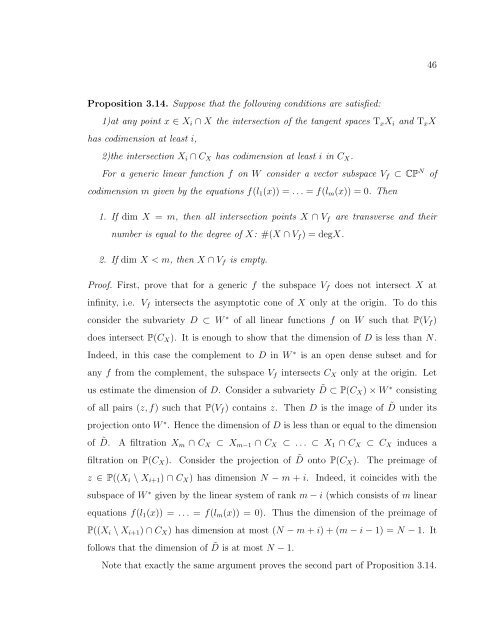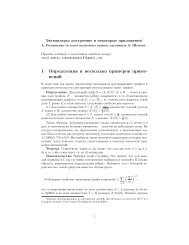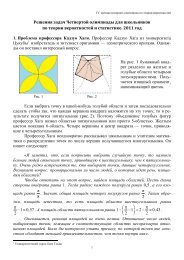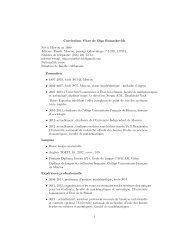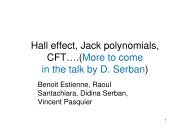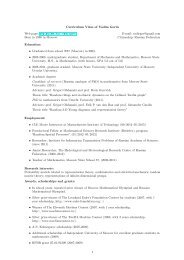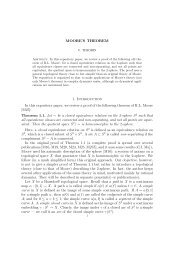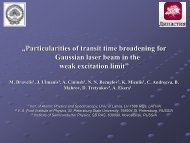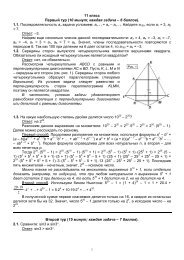a gauss-bonnet theorem, chern classes and an adjunction formula
a gauss-bonnet theorem, chern classes and an adjunction formula
a gauss-bonnet theorem, chern classes and an adjunction formula
You also want an ePaper? Increase the reach of your titles
YUMPU automatically turns print PDFs into web optimized ePapers that Google loves.
46<br />
Proposition 3.14. Suppose that the following conditions are satisfied:<br />
1)at <strong>an</strong>y point x ∈ X i ∩ X the intersection of the t<strong>an</strong>gent spaces T x X i <strong><strong>an</strong>d</strong> T x X<br />
has codimension at least i,<br />
2)the intersection X i ∩ C X has codimension at least i in C X .<br />
For a generic linear function f on W consider a vector subspace V f ⊂ CP N of<br />
codimension m given by the equations f(l 1 (x)) = . . . = f(l m (x)) = 0. Then<br />
1. If dim X = m, then all intersection points X ∩ V f are tr<strong>an</strong>sverse <strong><strong>an</strong>d</strong> their<br />
number is equal to the degree of X: #(X ∩ V f ) = degX.<br />
2. If dim X < m, then X ∩ V f is empty.<br />
Proof. First, prove that for a generic f the subspace V f does not intersect X at<br />
infinity, i.e. V f intersects the asymptotic cone of X only at the origin. To do this<br />
consider the subvariety D ⊂ W ∗ of all linear functions f on W such that P(V f )<br />
does intersect P(C X ). It is enough to show that the dimension of D is less th<strong>an</strong> N.<br />
Indeed, in this case the complement to D in W ∗ is <strong>an</strong> open dense subset <strong><strong>an</strong>d</strong> for<br />
<strong>an</strong>y f from the complement, the subspace V f intersects C X only at the origin. Let<br />
us estimate the dimension of D. Consider a subvariety ˜D ⊂ P(C X ) × W ∗ consisting<br />
of all pairs (z, f) such that P(V f ) contains z. Then D is the image of ˜D under its<br />
projection onto W ∗ . Hence the dimension of D is less th<strong>an</strong> or equal to the dimension<br />
of ˜D. A filtration Xm ∩ C X ⊂ X m−1 ∩ C X ⊂ . . . ⊂ X 1 ∩ C X ⊂ C X induces a<br />
filtration on P(C X ). Consider the projection of ˜D onto P(CX ). The preimage of<br />
z ∈ P((X i \ X i+1 ) ∩ C X ) has dimension N − m + i. Indeed, it coincides with the<br />
subspace of W ∗ given by the linear system of r<strong>an</strong>k m − i (which consists of m linear<br />
equations f(l 1 (x)) = . . . = f(l m (x)) = 0). Thus the dimension of the preimage of<br />
P((X i \ X i+1 ) ∩ C X ) has dimension at most (N − m + i) + (m − i − 1) = N − 1. It<br />
follows that the dimension of ˜D is at most N − 1.<br />
Note that exactly the same argument proves the second part of Proposition 3.14.


